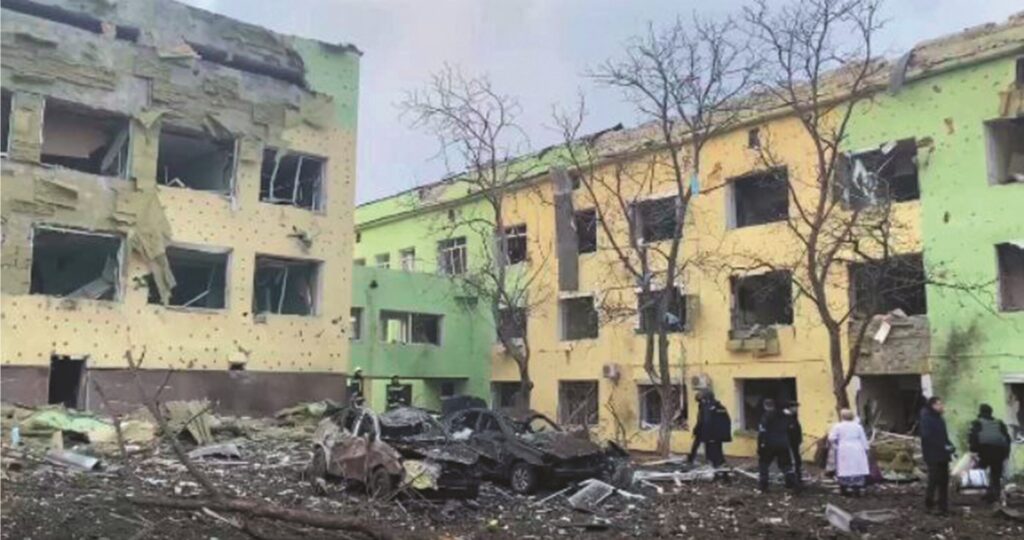
Until second decade of XX century Ukrainian territories were in different times included into Great Lithuania, Polish kingdom, Moscovian Kingdom, Osman Empire, Russian Empire and Austro-Hungarian Empire. After the World War I and the revolution in Russian Empire Ukraine have declared independence and sent the delegation to the League of Nations, but under the pressure of Bolshevik`s Russia Ukraine was not recognized as a nation and later was largely occupied by Russia, whereas Western regions were included in Poland and Romania. After the WWII started, USSR occupied also Western Ukraine. After the WWII Ukrainian SSR became a member of the United Nation, but de facto was fully controlled by USSR.
1920年代まで、ウクライナの領土は時代ごとに大リトアニア、ポーランド王国、モスクワ王国(ロシア・ツァーリ国)、オスマン帝国、ロシア帝国、オーストリア・ハンガリー帝国に統治されていた。第一次世界大戦ならびに時を同じく発生したロシア革命後にウクライナは独立を宣言したが、国際連盟に代表団は送ったものの、ロシアのボリシェビキ(1918年ロシア共産党へ)の圧力によりウクライナは国家として認められず、その後、国土の大部分をロシアに、西ウクライナ地域をポーランドとルーマニアに占領されることとなった。 第二次世界大戦が始まると、ソ連は西ウクライナ地域も占領した。第二次世界大戦後に、ウクライナSSR(ウクライナ・ソビエト社会主義共和国)は国際連合の加盟国となったが、ウクライナは事実上完全にUSSR(ソビエト連邦)の支配下にあった。
In 1990 USSR fell apart and Ukraine became an independent country as a result of referendum with the majority supporting the independence.
1990年にUSSRが崩壊し、ウクライナは国民投票の結果、過半数が独立を支持したため、ひとつの独立国となった。
In 2013-2014 – the Revolution of Dignity (Maidan-2014) – Pro-Russian President Yanukovych decided not to sign a political association and free-trade agreement with EU, which were declared earlier as a main political direction. A wave of protests and manifestation was raised over the country and the President and the government decided to forcibly suppress protesters. It was a critical moment in Ukrainian modern history, because hundreds of thousands of people went to protests all over the country, in Donetsk, Kharkiv and Luhansk as well as in Lviv, Zhytomyr and Vinnytsia, even though they did know the government can use the armed force against them. Maidan Nezalezhnosti (Independence square) in Kyiv was a main stage of this process. Ukrainian people demonstrated their will to be a part of Europe, but not to come back to the modern USSR with police state governing, and their will to develop democratic society and own national and political identity. More than 100 people paid for this will with their lives, because Yanukovych ordered to use guns against the protesters. As a result, the President was ousted and fled out to Russia.
2013年から2014年にかけて起こった「尊厳の革命(マイダン2014)」は、時の大統領で親ロシア派のヤヌコビッチが、それまで政治的な方向性として決定していたEUとの連合協定ならびに自由貿易協定に署名しないことを決定したことが契機となり発生した。ヤヌコビッチの決定に対する民衆の抗議とデモの活動はウクライナ全土に広がり、同元大統領とその政府はデモ参加者の強制鎮圧に踏み切った。 これこそがまさに、ウクライナの現代史における決定的な瞬間であった。まさにこの決定の結果、ドネツク、ハリコフ、ルハンスク、リヴィウ、ジトミル、ヴィニツィアなど、何十万人もの人々が全国各地で抗議デモに参加することになった。 キエフのマイダン・ネザレジノスチ(独立広場)は、まさにこの革命における中心的・象徴的な舞台だった。 ウクライナ国民は、ヨーロッパの一員となることを望み、ソビエト連邦のような警察国家(注:「法治国家」の対義語として用いられる警察権によって国民の統制を行う国家)には決して戻らないという強固な意志と、民主主義と自らの独立した国家的・政治的なアイデンティティを確立したいという民意を示したのである。これに対して、時の大統領であったヤヌコビッチは民衆に対する発砲を命じたため、100名以上の市民が犠牲となった。 最終的には元大統領はウクライナを追放され、ロシアに亡命した。
The early phase of the Russo-Ukrainian War soon quickly escalated into a Russian military intervention, the annexation of Crimea by Russia, unadmitted Russian military invasion to eastern regions of Ukraine and the creation of self-proclaimed breakaway states in Donetsk and Luhansk. This sparked the Donbas War, and culminated with Russia initiating a full-scale invasion of the country in February of 2022. Since that time there were the Battle for Kyiv, siege of Chernihiv, Sieverodonetsk, Bakhmut and Mariupol, mass bombing of Kharkiv, founding of mass graves in Bucha, Irpin, Izium and other cities, deoccupation of Kherson, the explosion of Ukrainian soldiers – prisoners of war in Olenivka jail, destruction of Kahovska Dam by Russians and catastrophic flood as a result. As of September, 2023, Ukrainian Armed Forces completely regained Kyiv, Chernihiv, Kharkiv regions, but the counter offense for Ukrainian South and East is still going on. Ukraine pays with destroyed cities, mined fields and blood of Ukrainians for its freedom and future in this fight against Russian occupation. At this moment the UN mission in Ukraine confirmed around 10000 civilian casualties on deoccupied territories. Estimated casualties on Russian occupied territories are much higher – only in Mariupol the number of deaths is between 25000 and 50000.
これがロシア・ウクライナ戦争の初期段階であったが、この事態はすぐにロシアの軍事介入へとエスカレートし、ロシアによるクリミアの併合、ウクライナ東部地域への一方的なロシアの軍事侵攻、ドネツクとルハンスクの一方的な独立国家の樹立へと発展した。これらの一連の軍事政策がドンバス紛争を誘発し、2022年2月にはロシアがウクライナに全面侵攻を開始したのだ。 それ以来、ロシア軍との間で生じたキエフ攻防戦、チェルニヒフ、セベロドネツク、バフムート、マウリポリの包囲戦、ハリコフへの大量爆撃、ブチャ、イルピン、イジウムなどでの集団埋葬場、ヘルソンの占領解除、オレニフカの捕虜収容所爆発、ロシア軍によるカホフカダム破壊事件とその結果の大洪水などが立て続けに起こっている。 2023年9月現在、ウクライナ軍はキエフ、チェルニヒフ、ハリコフ地方を完全に奪還したが、ウクライナ南部と東部での反撃は今も継続中である。破壊された都市、地雷が埋設された原野、そしてウクライナ人の命は、ロシアの占領に対するこの戦いの自由と未来を得るための戦いの代償的な犠牲となっている。 ウクライナが奪還した地域では現在、国連の調査によると約1万人の民間人の犠牲者が確認されている。ロシアによる占領地での死傷者数はさらに多く、マウリポリでの死傷者数だけでも25,000人から50,000人にものぼるとされている。
When the full-scale war of Russia against Ukraine started in the end of February, Ukrainian healthcare was forced to adapt quickly and to manage massive admissions, shortened supply, restricted mobility, patients care under the bomb shelling, organization of medical facilities in basements, sometimes without electricity and water, equipment and consumables shortage. Yet, the number of purposely damaged and destroyed medical facilities, vehicles, killed and wounded personnel and the percentage of the population without access to the medical care is incredibly high and still growing.
2022年2月末にロシアとウクライナの本格的な開戦後に、ウクライナの医療機関は、戦傷者の大量入院の受け入れ、医療材料などの供給不足、移動制限、爆撃下での患者の治療、時には電気も水もない地下室での仮設医療施設の設置、医療機器や消耗品の不足などへの迅速な対応を余儀なくされた。 しかし、攻撃目標・標的となり破壊された医療施設や車両の数、死傷者の数、医療を受けられない人口の割合は、信じられないほど高く、現在もなお増え続けている。
Exhibition Manager(展示責任者)
Oleksandra Riabets: MD, Bogomolets National Medical University (Kyiv, Ukraine); PhD student, Department of Neurosurgery, Juntendo University, Tokyo
Tetiana Yatsenko: Ph.D., Senior researcher, Palladin Institute of Biochemistry of NAS of Ukraine, Kyiv; JSPS Postdoctoral Research Fellow, Juntendo University, Tokyo